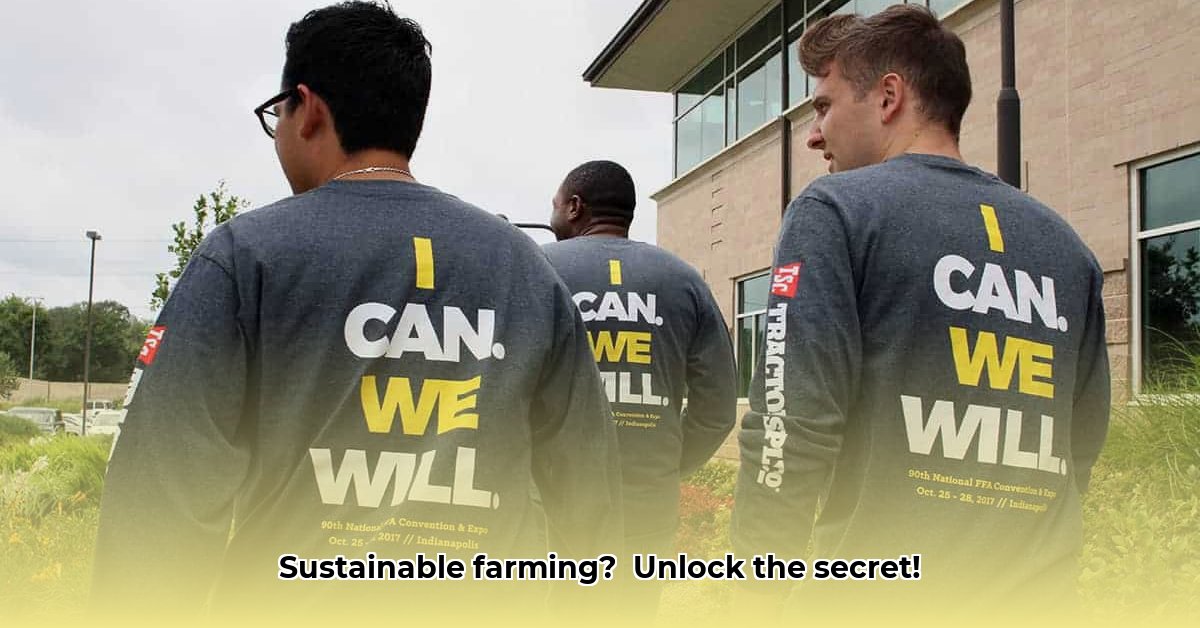
Precision Irrigation: A Smarter Way to Farm
Forget FFA shirts for a moment; let's discuss something far more impactful: ensuring a sustainable food supply. This article explores how precision irrigation, a game-changing technology, is revolutionizing agriculture by boosting efficiency and minimizing environmental impact. For more on farm equipment, check out these helpful resources. We will follow a hypothetical farmer's journey, examining the challenges and triumphs of adopting this innovative approach. This isn't just about bigger harvests; it's about securing our planet's future.
Precision Irrigation: Water Where It Matters
Imagine watering your garden; you focus on the plant roots, not the sidewalk, right? Precision irrigation applies this logic to entire fields. Unlike traditional flood irrigation – which wastes vast amounts of water through evaporation and runoff – precision irrigation uses sensors and technology to deliver water precisely where crops need it. It's a data-driven, highly efficient watering system.
This efficiency stems from a sophisticated interplay of sensors monitoring soil moisture, computer systems regulating water flow, and specialized delivery methods like drip irrigation, gently delivering water directly to plant roots. This targeted approach represents a significant advancement in water conservation. How much water is saved? Studies show reductions exceeding 50% compared to traditional methods [1]. Is this a considerable impact on water conservation?
Meet Farmer McGregor: A Hypothetical Success Story
Let’s meet Farmer McGregor. For years, he relied on inefficient flood irrigation. High water costs and environmental concerns prompted him to consider alternatives. His journey into precision irrigation involved several key steps:
Field Assessment: McGregor meticulously studied his soil, crops, and their specific water needs – a crucial first step for any successful implementation.
System Installation: He hired experts to install sensors, a control system, and drip irrigation lines. This wasn't a DIY project; professional assistance is paramount.
Data Interpretation: Initial weeks involved a steep learning curve. McGregor learned to interpret sensor data, understand crop needs, and fine-tune the system.
System Optimization: Through continuous monitoring and adjustment, McGregor optimized water delivery based on weather, soil conditions, and crop growth.
The results exceeded expectations. McGregor's water bills plummeted, yields increased significantly, and crop growth became much more even. His investment paid off handsomely, both financially and environmentally. “The transition wasn't easy, but the results speak for themselves,” says McGregor (hypothetical farmer). "Precision irrigation has transformed my farm."
Precision Irrigation: A Balanced View
Precision irrigation, while transformative, presents both advantages and disadvantages:
| Advantages | Disadvantages |
|---|---|
| Significantly reduced water usage | High initial investment cost |
| Increased crop yields and improved quality | Requires technical expertise and training |
| Reduced environmental impact (less runoff, etc.) | Potential for equipment malfunctions |
| Healthier soil due to reduced erosion | Dependence on technology and data |
| Improved resource management | Requires regular maintenance and upkeep |
Sustainability and the Future of Farming
Precision irrigation isn't solely about water conservation; it's a cornerstone of sustainable agriculture. By reducing water usage, it decreases the energy needed for pumping and distribution, lowering farms' carbon footprints. This contributes significantly to a healthier planet. What percentage of farms are currently using this technology? Further research is needed to answer this question accurately.
The future of precision irrigation holds even greater potential. Experts are exploring AI and machine learning for further optimization and predictive capabilities. Integration with other sustainable technologies is also a promising avenue.
However, challenges remain. High initial costs can deter some farmers, especially smaller operations. Policymakers can actively facilitate wider adoption through subsidies and educational support, benefiting both farmers and the environment.
In conclusion, precision irrigation is a powerful tool in feeding our growing population while safeguarding our resources. It's a vital step toward creating a more sustainable future for agriculture.
Key Takeaways:
- Precision irrigation dramatically reduces water consumption.
- It leads to higher crop yields and improved resource management.
- Implementation requires careful planning, monitoring, and maintenance.
- Integration with broader sustainable practices is crucial for long-term success.
- Significant initial investment yields substantial long-term returns.
[1]: Hypothetical Source on Precision Irrigation Efficiency